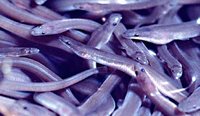American eel
|
|
| American Eel | ||||||||||||||
|---|---|---|---|---|---|---|---|---|---|---|---|---|---|---|
| Missing image Anguillarostratakils.jpg Anguilla rostrata | ||||||||||||||
| Scientific classification | ||||||||||||||
| ||||||||||||||
| Binomial name | ||||||||||||||
| Anguilla rostrata |
The American eel (Anguilla rostrata) is a fish found on the Eastern coast of the United States. It has a snake-like body with a small sharp pointed head. It is brown on top and a tan-yellow color on the bottom. It has sharp pointed teeth but no pelvic fins.
| Contents |
Reproduction
Rostratamuk.jpg
Rostrataluk.jpg
The female American eel spawns in salt water, and it takes 9 to 10 weeks for the eggs to hatch. The female can lay up to 4 million buoyant eggs a year, but frequently dies after egg-laying.
Habitat
The eel likes fresh water, and is found around the Atlantic coast including the Chesapeake Bay. It prefers to hunt at night, and during the day it hides in mud, sand, or gravel.
Economic value
American Eels are economically very important to the East Coast and rivers where they travel. They are caught by fishermen and sold, eaten or kept as pets. Eels help the Atlantic coast ecosystem by eating dead fish, invertebrates and carrion, and might even eat insects if hungry enough; it will even eat its own family.
Recreational Angling Importance
Although many anglers are put off by the snake-like appearance of eels and the prodigious amounts of slime they produce when captured, eels are in fact exceptionally good fish. They are usually caught by anglers fishing for something else. The world record weight for the American Eel is 9.25 pounds.
- see also

